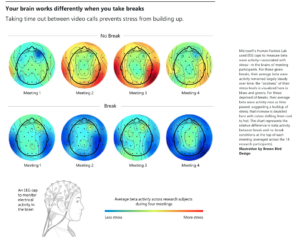Written by Karen Green

As Singapore moves back into a WFH period it is important to consider what we know about balancing both productivity and wellness.
Prior to Covid, there was strong research that allowing people the flexibility to work from home (WFH) a few days a week resulted in increased engagement. In 2020 throughout the first year of the pandemic, management articles were full with the benefits of WFH and more recently how to build a hybrid future for workers.
But as 2021 rolled around and the pandemic kept much of the world in a rolling state of lockdowns, opening up, wfh, hybrid, back the office realities of managing this dynamic are managing effective work is becoming far more apparent.
 New data out this month from the University of Chicago is reminding us to check on our workers and the importance of engaging them in a conversation about the reality of work productivity as they work from their home. More importantly, it should encourage us to invest in the leadership capabilities we need to build engaged teams and workers regardless of working at home, the office or anywhere else.
New data out this month from the University of Chicago is reminding us to check on our workers and the importance of engaging them in a conversation about the reality of work productivity as they work from their home. More importantly, it should encourage us to invest in the leadership capabilities we need to build engaged teams and workers regardless of working at home, the office or anywhere else.
In this recent study, they compared the personal analytics of 10,000 IT workers in an Asian context from before Covid and then after work from home occurred.
The results give a telling picture:
- The average output of work didn’t change however the time it took to get the work done significantly increased.
- Total hours worked increased by roughly 30%, including a rise of 18% in working after normal business hours.
- A lot of time was taken up coordinating all the meetings
- Time spent on coordination activities and meetings increased, which meant that uninterrupted work hours shrank considerably.
- Employee support and development time was impacted
- Employees also spent less time networking and received less coaching and 1:1 meetings with supervisors.
- WFH and managing children significantly impacted productivity
- Employees with children living at home increased hours worked more than those without children at home and suffered a bigger decline in productivity than those without children.
WFH and hybrid WFH is here to stay for some time to come and organisations that invest in the leadership capability to manage this dynamic will be critical to long term productivity and success.
Some key ways you can help your employees with their productivity
Beware of panic productivity
The human brain has a strong need to understand how we belong and fit within our community. If working from home comes with increased pressure, anxiety and fear for jobs we can get into a state of panic productivity.
Panic productivity looks very busy with a lot of things happening and everyone logging into lots of many meetings. However, when you look closely at the work you may find that much of it is coordination based activities and ‘noisy work’ rather than the more valuable knowledge-based work. Helping our employees diagnose noisy work and then develop good work routines is critical to managing panic productivity.
NB # Discuss boundaries and workday needs. Increase the level of clarity on work emails, notifications and response times. Give/ask for clear permission to turn off and stop work.
Encourage regular breaks
 Your brain works better when you take breaks between zoom meetings. Short breaks of 5-10 mins can make a significant difference to the stress build up in the brain. Recent work by Microsoft on virtual meetings and the brain clearly shows the power of back to back calls. This impacts how you make decisions, process information and manage complex emotions in the workplace.
Your brain works better when you take breaks between zoom meetings. Short breaks of 5-10 mins can make a significant difference to the stress build up in the brain. Recent work by Microsoft on virtual meetings and the brain clearly shows the power of back to back calls. This impacts how you make decisions, process information and manage complex emotions in the workplace.
A really simple way to change this dynamic is to schedule breaks or to change your default meeting time to 25 or 50 minutes.
Collaboration and connections
There was a generally positive time trend on collaboration and networking activities in University of Chicago research but there was a clear negative impact of WFH on the number of individuals with whom employees share meaningful interactions.
In any organisation we know that there are people that do the connector work, they often don’t show up in the team lists or even in traditional places in the organisational charts but they play essential roles in how your business functions.
Consciously check on who is attending meetings and who might be left out. Plan and organise small group cross-functional discussions just to build dialogue and shared learnings.
Encourage people to actively talk about alternative viewpoints and to explore ideas from different perspectives.
Work on trust and inclusion
We are seeing an explosion of trust-related issues that come from a combination of pandemic anxiety and the increased effort that we have to do to help our brain’s build trust in a remote dynamic. Building trust within teams and individuals requires a conscious effort by leaders. We have to replace all the non verbal data our brains would get in a face to face environment with new data in a remote system.
There are some simple ways to help the flow of trust data
- Have short sprints of work with increased clarity on deliverables so everyone can see what the team is doing and how they are achieving outcomes.
- Increase transparency and the open flow of information. (Don’t hoard data)
- Think about how you can get equal participation from all attendees in meetings.
- Amplify onboarding techniques in a virtual world. Don’t leave it to HR but make it a whole of team effort. Things like assigning multiple people to introductions of new members can help.
Work from home comes with increased anxiety and stress for many workers. How we manage this anxiety and help people to find balance and space to be at work and then at home will go a long way to managing this engagement and productivity.
Having people work longer doesn’t mean more productivity for your business.
References
Work from Home & Productivity: Evidence from Personnel & Analytics Data on IT Professionals University of Chicago, Becker Friedman Institute for Economics Working Paper No. 2021-56
WTI Pulse Report Research Proves Your Brain Needs Breaks https://www.microsoft.com/en-us/worklab/work-trend-index/brain-research
Mortensen, M Gardner, H (2021) WFH Is Corroding Our Trust in Each Other. Harvard Business Review. https://hbr.org/2021/02/wfh-is-corroding-our-trust-in-each-other
